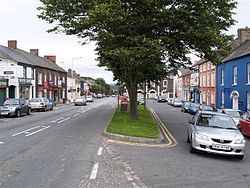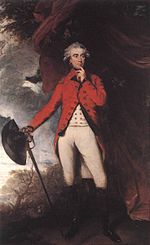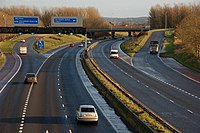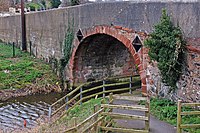Moira, County Down
| Moira | |
| County Down | |
|---|---|
 The main street in Moira | |
| Location | |
| Grid reference: | J1560 |
| Location: | 54°28’48"N, 6°13’55"W |
| Data | |
| Population: | 4,221 (2008 estimate) |
| Post town: | Craigavon |
| Postcode: | BT67 |
| Dialling code: | 028 |
| Local Government | |
| Council: | Lisburn and Castlereagh |
| Parliamentary constituency: |
Lagan Valley |
Moira is a village in County Down, in the north-west of the county, near the borders with the counties of Antrim and Armagh. The M1 motorway and Belfast–Dublin railway line run nearby.
The village has existed since time immemorial. In a 2008 estimate the Northern Ireland Statistics and Research Agency approximated the population of Moira to be 4,221.
Contents
Name
The origin of the name 'Moira' is somewhat uncertain. It seems to be derived from the Irish Maigh Rath, which may mean either 'plain of the wheels'[1] or 'plain of the ringforts'.[2] Another Irish form of the name is Mag Rath.[3]
History
Prehistory to Early Modern Period
Moira has been a settlement for at least 1,500 years. For the period it consisted most probably only of small dwellings surrounded by several earthen ringforts. Evidence of three such forts still remain. The best known of these is the so-called "Rough Fort", situated on the Old Kilmore Road. However the remains of "Pretty Mary's Fort" exist behind the Waringfield residential area. Finally evidence of a third ringfort can be found near Claremont.[2]
The existence of these primitive defences, coupled with the good-view afforded from the top of Moira hill, made the settlement strategically valuable. Proximity to Lough Neagh enhanced this value. Accordingly, during the repeated power struggles of the first millennium the area was often fought over, and eventually witnessed the largest battle in the history of Ireland when three tribal kings contested the area to determine supremacy in Ulster and beyond. This was the Battle of Moira. Its impact on Moira is still felt; two townlands still bear battle names, Aughnafosker (meaning 'field of slaughter') and Carnalbanagh (meaning the 'Scotsman's grave').[2] After the battle a Bishop by the name of Ronan Finn (who was later canonized) was alleged to have created a monastery in the area.[2]
The mediæval period itself remains shrouded in mystery. It is known that the town and its hinterland were under the control of the O'Lavery Clan for a considerable period. They were Roman Catholic families who held sway in large parts of Armagh. Indeed, prior to the Nine Years' War Ulster was the most Gaelic part of Ireland.[4] There were few towns, few roads and much of the country was thickly wooded.[5] However the subjugation of Ulster by the victorious armies of Elizabeth I greatly reduced the clout of gaelic hierarchs, the O'Laverys included. But it was their participation in the Irish Rebellion of 1641 doomed their dominance. The Royal authorities crushed the rebellion and confiscated vast amounts of native Irish property, in Moira as in the rest of Ireland.[2] As a direct result of this the Protestant plantations of Ulster (which began in 1606) was accelerated.
Today Moira is an overwhelmingly Protestant village.
The Rawdon family
In 1631 Major George Rawdon, a wealthy man from the village of Rawdon in Yorkshire, settled in Moira. During the Irish Rebellion of 1641 he and 200 English soldiers helped defeat the army of Sir Phelim O'Neill and re-secure Moira and its environs for the Crown. In 1651 an officer by the name of Major de Burgh purchased a small estate and built a brick house in Moira. This house, the forerunner of Moira Castle, was subsequently purchased by Rawdon. Following his actions in putting down rebellion Rawdon subsequently purchased vast amounts of land in the area (most probably financed by confiscations from the dead or subjugated rebels), and was said to have developed it greatly.[2] In 1665 he was created a baronet by Charles II. At some point in his life he became a Member of Parliament. Somewhat unfortunately he was nicknamed the 'Great Highwayman' for his development of roads infrastructure in and around Moira. Sir George Rawdon was succeeded in his title by his son Sir Arthur Rawdon.
Sir Arthur]] (who would also become an Irish MP) became a General in the armies of King William III during the Jacobite War in Ireland. He was quickly besieged in Derry, but managed to escape. After the war, with the Protestant Ascendancy of which he was a part yet again restored, Sir Arthur (who had presumably profited greatly from the war) returned to Moira. Having inherited the brick mahor house his father had purchased he decided to expand it greatly, and it became one of the largest residences in the whole island, to be called Moira Castle.[2] The castle, which in fact was a mansion, was also accompanied by vast gardens. These gardens became world famous. In 1690 Sir Arthur utilised his friendship with fellow Downshire-born botanist Sir Hans Sloane, and acquired from him the seeds of 400 exotic plants, and instructions in how to grow them. To fit his ends Sir Arthur also constructed in Moira the first hothouse in Europe.
The subsequent baronets maintained the gardens (though the hothouse did not survive) for generations. In 1723 Sir John Rawdon, 3rd Baronet helped fund the construction of the Anglican Moira Parish Church, dedicated to St John.
The Lords Rawdon
In 1750 Sir John Rawdon, 4th Baronet was raised to the peerage by King George II as the Baron Rawdon of Moira. He subsequently flirted with Methodism, and invited John Wesley to speak at Moira Church. This caused a major religious rift in the town.[2] And though Wesley did speak, he did so from the grounds of Moira Castle, not the church for which the Rawdons had largely paid. He was also granted a higher title in 1762 by King George III, when he was made Earl of Moira.
In addition to flirting with Methodism Lord Rawdon also flirted with Irish self-government (albeit under the Ascendancy), opposing the efforts of William Pitt to forge closer links with Great Britain in the first decade of his Ministry. His death in 1793 was significant in Moira history, in that it marked the largest funeral in the history of Ireland, a testament to his extensive political connections. Over four hundred carriages were in procession. This Lord Rawdon is buried in the family crypt in the church.[2]
On the first Earl's death, his son Francis Rawdon-Hastings inherited the earldom became the Earl of Moira. A respected general and politician with significant influence in London, his time as head of the family was nevertheless negative for the town of Moira, which had risen greatly in prestige as a result of his predecessors. He neglected the gardens in the Moira estate, which subsequently declined into decay. He also spent the vast majority of his time in Great Britain.
Moira 1800-Present
The 2nd Earl was raised to a yet-higher rank of the peerage in 1816, when he was created Marquess of Hastings, subordinating the Moira title.
Lord Hastings would be the last member of the Rawdon family to reside in Moira Castle (which he had always used as a secondary residence in any case). In 1805 he sold it to Sir Robert Bateson, 1st Baronet, who also did not use it as a primary residence. The status of Moira thus declined considerably. The Rawdons' legacy would linger, however, with several streets and housing developments bearing their name centuries later.
The Acts of Union had reduced the power of the Ascendency, and Moira was now directly governed by London instead of Dublin. In addition the Great Reform Act had reduced the ability of landowners in general and lords in particular to control Moira.
Moira itself continued to develop during this period. A canal was built to the north (which ran along the boundary between the counties of Antrim and Down), and a Market Hall completed at the expense of the Bateson family in about 1810.[6] It was considered to have market the completion of the village. In 1841 Moira railway station was completed, and is now the oldest such structure on the island of Ireland. Moira Castle itself was vacated by the Batesons, and was demolished during the Victorian Era. A few gate stumps remain, as does some stepping for the famous gardens, and the dug-out cellar.
During the Second World War the grounds of Moira Demesne (as the Castle had become known) were used by the army as a medical centre.
Moira remained relatively uneventful for most of the 20th century, but did not escape The Troubles: on 20 February 1998 dissident republicans exploded a 500 lb car bomb outside the police station, injuring 11 people. The blast was so loud that it could be heard fully twenty miles away in Belfast.[7]
Transport
Moira is well located in terms of infrastructure. It is served by Moira railway station, which is a stop along the Newry to Bangor line. The station was originally built by the Ulster Railway, which ran beyond Portadown and went to Armagh. The station is conveniently close to the M1 motorway, with Moira Roundabout serving as a major junction. The proximity of Moira to both Belfast and Lisburn has meant that Moira has become something of a commuter village in recent decades. Unfortunately Moira is also situation directly along the main road to Lurgan, which creates considerable traffic jams, particularly during rush hour. The 51 bus service runs from Portadown to Belfast regularly, with several stops in the town.
Sport
- Football:
- Moira FC (junior)
- Moira Albion
Namesakes
Due to the prevalence of the Rawdon family in British Imperial affairs, several places in the world are named after Moira, County Down, usually via the noble title. These include;
- Moira in Leicestershire, a former mining village largely built by the Rawdons.
- In Ontario, Canada:
- Moira
- The Moira River, and the Moira Lake
Outside links
| ("Wikimedia Commons" has material about Moira, County Down) |
References
- ↑ http://www.ulsterplacenames.org/PDF%20Files/Antrim_%28Crumlin_ward%29_%28C._Dunbar%29.pdf
- ↑ 2.0 2.1 2.2 2.3 2.4 2.5 2.6 2.7 2.8 "Moira - Lisburn.com". lisburn.com. http://www.lisburn.com/books/moira/moira1.html.
- ↑ "The Battle of Mag Rath". askaboutireland.ie. http://www.askaboutireland.ie/reading-room/history-heritage/folklore-of-ireland/carlow-folklore/the-story-of-mad-sweeney/the-battle-of-mag-rath/.
- ↑ R. R. Madden, The United Irishmen, Their Lives and Times Vol 1, J.Madden & Co (London 1845), Pg. 2-5.
- ↑ Cyril Falls: The Birth of Ulster.London, Constable and Company Ltd. 1996. Pages 11-12. P. Robinson The Plantation of Ulster. Belfast, Ulster Historical Foundation. 2000. Page 28. Dr. I. Adamson: The Identity of Ulster. Bangor, Pretani Press. Third Impression, 1995. Page 11.
- ↑ http://2hearts.co.uk/Moira_history_2011.pdf
- ↑ "Dissident Republicans bomb Moira, County Down. February 1998". YouTube. 30 January 2010. http://www.youtube.com/watch?v=QnbAye3SzzE.


